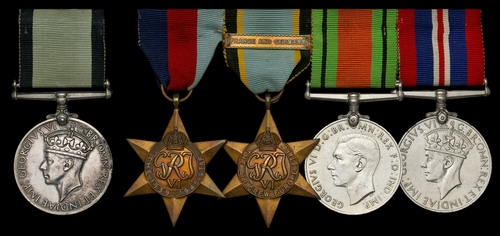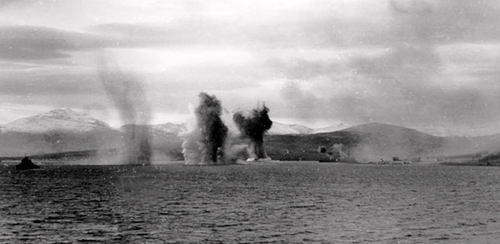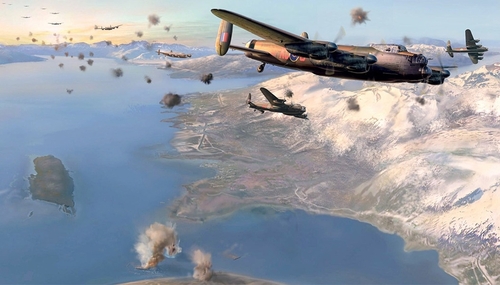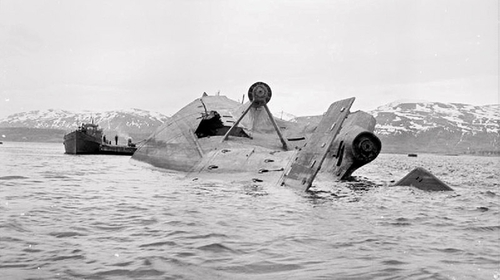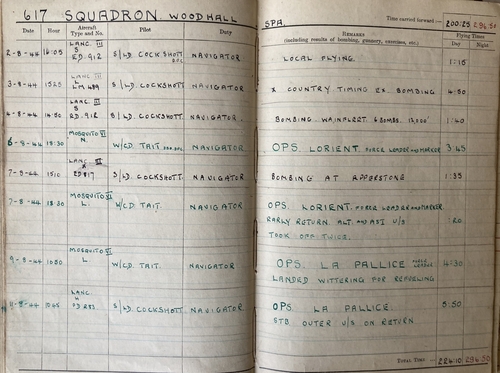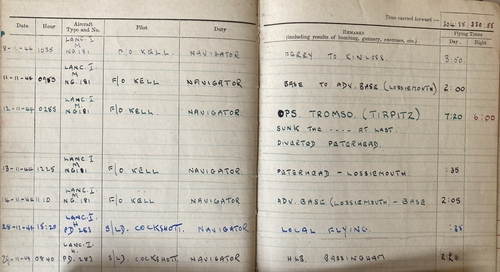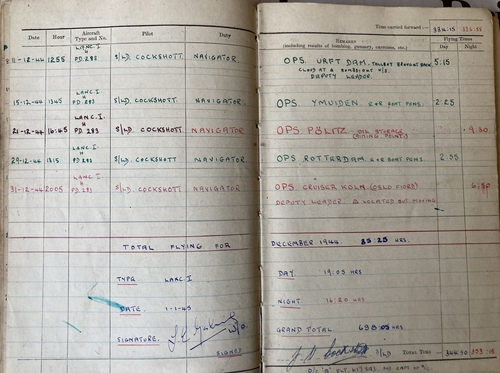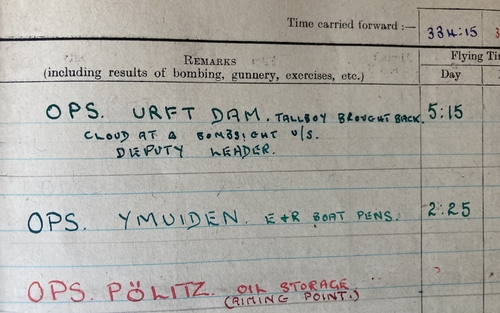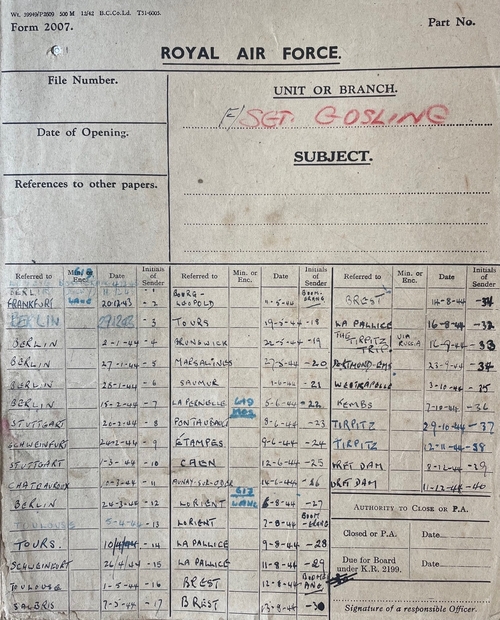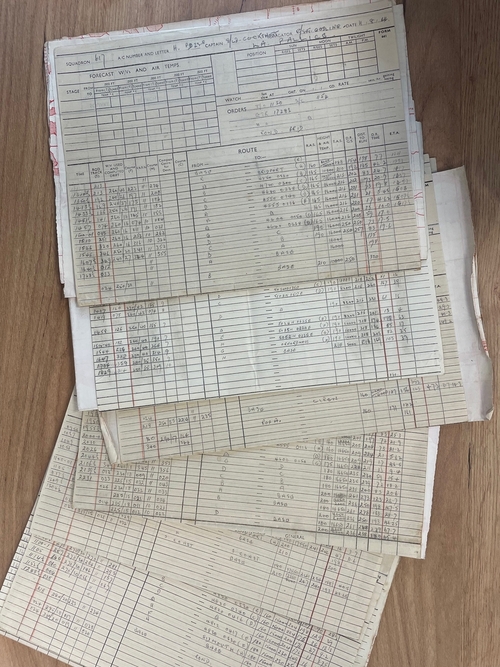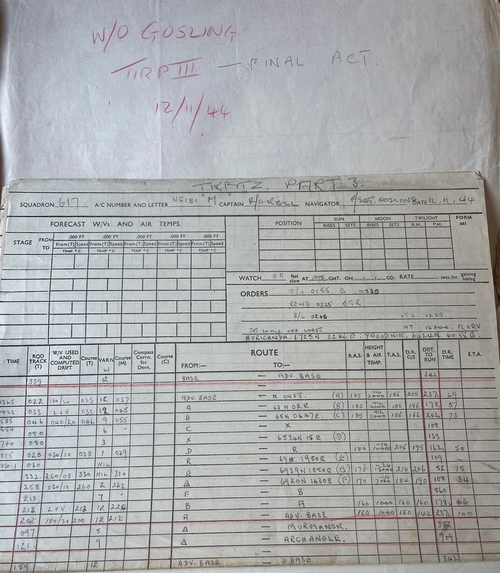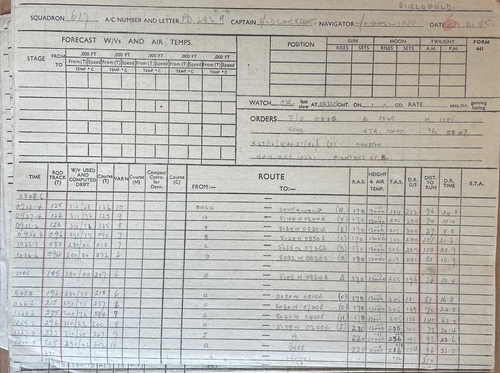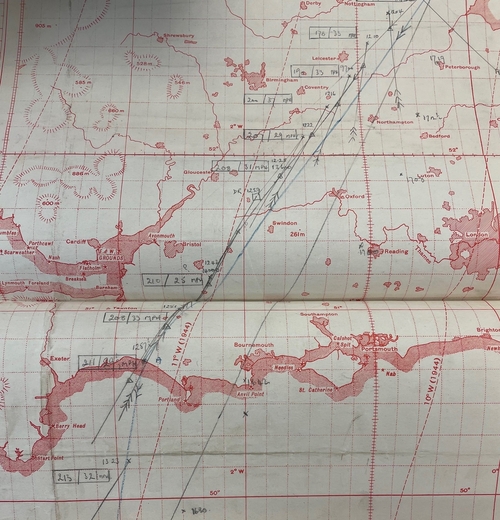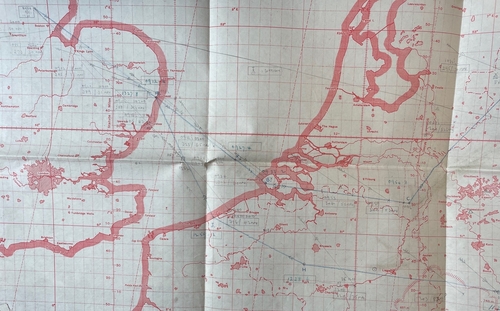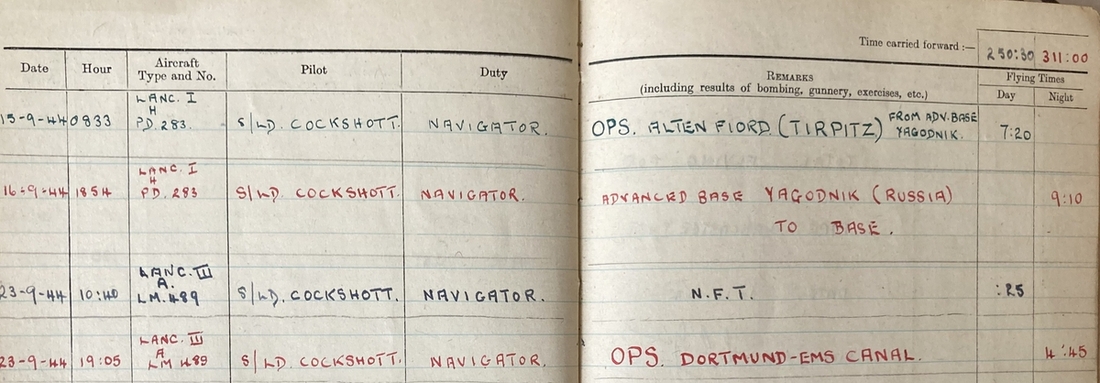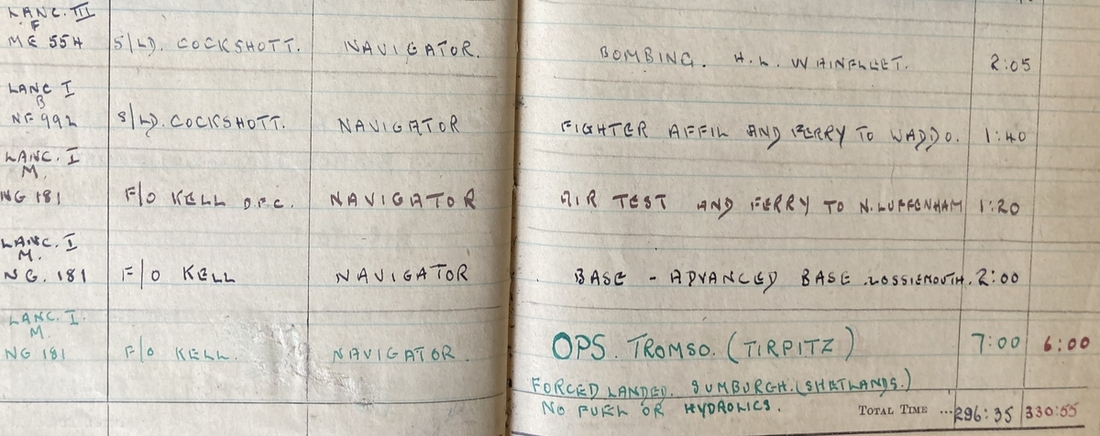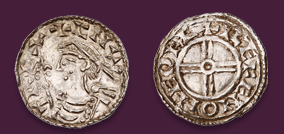Auction: 25003 - Orders, Decorations and Medals
Lot: 219
(x) An outstanding Second War C.G.M. group of five awarded to Warrant Officer L. E. Gosling, No. 617 'Dambusters' Squadron, Royal Air Force Volunteer Reserve, whose remarkable wartime career is preserved in an accompanying archive of his navigational charts for each of his sorties
Having already flown 25 of them in No. 619 Squadron - among them seven trips to Berlin - he transferred to the 'Dambusters' in August 1944 and commenced his second tour as navigator in a Mosquito piloted by Wing Commander J. B. 'Willie' Tait, D.S.O., D.F.C.
He then joined the Lancaster crew of one of 617's American pilots - Squadron Leader J. Cockshott, D.F.C. - and raised his tally of sorties to the 56-mark, most of them of the 'Tallboy' and 'Grand Slam' precision variety, against E- and U-boat pens, dams and viaducts, but most memorable of all was surely his part in the squadron's famous attacks on the Tirpitz
Conspicuous Gallantry Medal (Flying), G.VI.R. (W./O. L. E. Gosling, R.A.F.); 1939-45 Star; Air Crew Europe Star, clasp, France and Germany; Defence and War Medals 1939-45, the first with two minor edge bruises, good very fine (5)
C.G.M. London Gazette 18 October 1945, the original recommendation states:
''Warrant Officer Gosling has operated continuously since December 1943 and has completed the impressive total of 56 operational sorties. He volunteered to operate for two consecutive operational tours with No. 617 Squadron and then to continue operating after those two tours were completed.
His record of attacks is undoubtedly outstanding. It includes many of the most heavily defended German targets with seven attacks on Berlin. These attacks called for a high standard of navigation and Warrant Officer Gosling has never failed to show that he is a navigator of more than ordinary ability.
In particular, during the three attacks on the German battleship Tirpitz, in which he took part, he demonstrated his skill despite the long and arduous flights which were involved. The flight to a Russian base from which the first attack was delivered took place in appalling weather conditions and Warrant Officer Gosling was successful in directing his captain to this base even though no navigational aids were available to him.
In spite of many hazards, Warrant Officer Gosling has, without fail, achieved and maintained a most praiseworthy standard of navigation. His coolness, his methodical and accurate work in the face of severe opposition has invariably enabled his captain to complete his sortie successfully. His courage and determination to engage the enemy and his intense desire to keep on operations has been an inspiration and has own him the admiration and respect of all ranks. I strongly recommend that his gallant services be recognised by the award of the Conspicuous Gallantry Medal.'
Leonard Eric Gosling was born in Coventry, Warwickshire on 8 August 1921 and was working locally as a clerk on enlisting in the Royal Air Force Volunteer Reserve in June 1940.
Initially employed as a radar operator, he commenced training as a navigator in August 1942, but it was not until the end of the following year that he received his first operational posting.
1st operational tour - No. 619 Squadron - 25 sorties
And that posting was to No. 619 Squadron, a Lancaster unit based at Woodhall Spa, in December 1943, in which capacity he flew his first sortie - with the American ex-Dambuster Lieutenant Nick Knilans, D.S.O., D.F.C., at the helm - to Leipzig on the 4th. As it transpired, they had to return to base early. Then, on the night of the 16th, he flew with another pilot - Flight Lieutenant Sanderson - in a strike on Berlin.
Thereafter, however, Gosling flew as navigator to Wing Commander J. R. Jeudwine, D.S.O., O.B.E., D.F.C., the squadron C.O. And first up on the Wingco's radar was a trip to Frankfurt, followed by another sortie to the 'Big City' before the month's end. And since, in fact, Bomber Command's offensive against Berlin was at its zenith, Gosling and his crew had to undertake three further sorties to the German capital in January 1944. So, too, another, in February, when they were accompanied by a U.S. War Correspondent. The latter's report was published in the Sunday Express on 20 February, from which the following extract has been taken:
' … But the snowy cloud surface stretched so endlessly and the flares were so huge and all the distances so great that for a long time as we prepared to enter pour bombing run, it seemed as if we were standing still.
It was like trying to run from danger in a dream - or, as our skipper later put it: "It's like walking down Regent Street without your trousers on. You feel so naked and so alone, and somehow so embarrassed."
As our fantastic snail's pace drew us gradually nearer our objective combats dotted the sky with savage bursts of cannon and the crisp sparkle of machine-gun fire.
Flak began bursting beneath us, and either its steady concussion or rough air, or the slipstreams of other craft periodically bumped our ship.
Evasive action at this point became necessary and the Christmas trees and the snow and flashing globes of flak whirled - or seemed to whirl - above and bedside and beneath us.
Now we were over the target. From this point, until we dropped our bombs our course had to be held straight and true and steady while the bomb-aimer plied his trade. Whatever might be thrown at us now, there must be no evasive action, no dodging or ducking or saving of skins, only the slow, steady bombing run, until the cry of "Bombs gone!" and the long voyage home.
As we neared the English coast, our navigator [Gosling] achieved one of those happy irrelevancies which lodge in in the mind for a lifetime. "Does anybody know what the date is?" he asked.
It was February 15, 1944, and I will never forget it. Neither, I trust, will Berlin.'
Sorties to Stuttgart and Schweinfurt followed in quick succession and March commenced with a return trip to the former - this time with a Commander from the Fleet Air Arm as a passenger - followed by sorties to Chateauroux and, yet again, the 'Big City'. Then in April - with an Air Commodore Sharpe as 2nd pilot - Gosling and crew attacked a target in Toulouse. It was about this time the Wingco was appointed 'Force Leader', in which role he flew a sortie to Tours before the end of the month, followed by another strike on Schweinfurt.
With D-Day and the Allied landings fast looming up on the horizon, pilot and crew were now allocated to further French targets, among them return trips to Toulouse and Tours. But the most memorable outing in May was likely a strike on the ammunition depot at Salbris, for the attack was carried out under conditions of full moon and in the face of strong enemy fighter opposition. Nevertheless, the Wingo, as Force Leader, remained in the target area for over 30 minutes, whilst on his bombing run he was twice attacked by a Dornier 217. According to his D.S.O. citation, he displayed 'his customary fortitude, completed his bombing run and then proceeded to adopt such effective combat manoeuvres as to render the enemy's fire nugatory.'
In June, after attacks on the Saumur tunnel and the enemy coastal defences at La Pernelle, Gosling changed seats from his Lancaster to a Mosquito, the Wingco now having been elected a force 'marker'. Thus, four such sorties being flown before the month was out, including an operation against the river bridges at Caen on the 12th. On that occasion, on reaching the target area, their Mosquito's port engine was hit by anti-aircraft fire and put out of action at a height of only 1,000 feet. Notwithstanding that fact - and ongoing 'very hot' flak - the Wingco and Gosling stuck around to ensure all was going smoothly, before handing over to the deputy marker and limping back to base on one engine.
2nd operational tour - The Dambusters
Following a short rest in July 1944, and with 25 sorties under his belt, Gosling was posted to No. 617 'Dambusters' Squadron in No. 5 Group.
Command of the elite unit had recently been handed to Wing Commander J. B. 'Willie' Tait, D.S.O., D.F.C., and it would appear he had been tipped off about Gosling's talents as a navigator. Certainly, the pair of them flew three sorties in a Mosquito in early August, acting as Force Leader in attacks on the U-boat pens at Lorient and La Pallice.
In fact, equipped with Barnes Wallis's 12,000lb. 'Tallboy' bomb - and new precision bomb sights - the 'Dambusters' were assigned to a spate of such specialist targets over the coming months. And in that respect, Gosling found a permanent berth as navigator to an American pilot, Squadron Leader J. Cockshott, D.F.C., the pair of them flying their first sortie together on the 11th of August, namely another strike on La Pallice. And before the month was out, they flew three further 'Tallboy' operations against the U-boat pens at Brest, taking flak hits in two of them.
Tirpitz
Meanwhile, and second only to the squadron's legendary Dams Raid by way of fame, another significant target was presented the precision specialists: the Tirpitz.
Here, then, Gosling's part in all three of the attacks mounted by Nos. 9 and 617 Squadrons, the first of them - Operation 'Paravane' - being undertaken in September 1944, when 'Willie' Tait led a force of 37 Lancasters to an airfield at Yagodnik in northern Russia. Owing to low cloud, Gosling's crew had to make a forced landing at nearby Vestcova, but they caught up with the main force in time for the attack on Tirpitz in Kaa Fjord on the 15th. Despite smoke obscuring the target, Tirpitz was so severely damaged that German High Command reduced her function to that of a defensive battery in the event of an invasion.
But that decision remained unknown to Allied intelligence and another attack - Operation 'Obviate' - was mounted on the enemy battleship at her new lair in at Tromso in October.
First, however, Gosling and his crew carried out three further sorties, including the breaching of the sea wall at Westkapelle and the sluice gates at Kembs, in which latter trip their Lancaster sustained flak damage. Following these sorties, Gosling was temporarily transferred to Flying Officer A. E. Kell's crew.
And it was under Kell's captaincy that he now participated in Operation 'Obviate', the attacking force departing Lossiemouth in Scotland on 29 October. But the attack proved unsuccessful, owing to heavy cloud cover over Tromso. Nor did Gosling and crew have a smooth trip. The contrary. They had to make a forced landing at Sumburgh in the Shetlands ('No fuel. No hydraulics').
Finally, however, on 12 November - in Operation 'Catechism' - Gosling and 617 returned triumphant to Lossiemouth, the Tirpitz having capsized after being hit by three 'Tallboy' bombs, a historic moment captured by his log book entry: 'Ops. Tromso (Tirpitz). Sunk the ------ at Last.'
Beyond the Tirpitz
Following Tirpitz's demise, and back in Squadron Leader Cockshott's crew, Gosling now commenced a flurry of daylight operations, including a brace of 'Tallboy' trips to the Urft Dam in December - both, as it happened, had to be aborted.
So, too, in the same month, strikes on the E- and R-boat pens at Ijmuiden and Rotterdam, the synthetic oil refinery at Politz and an enemy cruiser in Oslo Fjord, followed by a return trip to Ijmuiden and a brace of aborted attacks on Bielefeld Viaduct in February, in one of which Gosling's Lancaster was hit in its port inner engine.
Two further attempts to hit the viaduct in March were also aborted, once again on account of 10/10 cloud cover, but a trip to Arnsberg Viaduct was a resounding success, Gosling and his crew now operating with Barnes Wallis's latest gift - the 22,000lb. 'Grand Slam' bomb.
To carry the mighty bomb, 617's Lancasters had to undergo major modification, including strengthening of the undercarriage and removal of the bomb doors. So, too, somewhat disconcertingly, the removal of the front and mid-upper gun turrets. Even so, observers on the ground noticed the Lancaster's normally straight wings flex on taking off.
In the second half of March, Gosling rounded off his second tour in style, carrying out three further 'Grand Slam' viaduct sorties, all three ending with direct hits. And Bremen's main railway bridge suffered a similar fate on the 23rd, when the attacking force ran into Me. 262s. With the steady hands of Squadron Leader Cockshott at the helm, Gosling's Lancaster made it home, although for the record it is worth noting his aircraft was damaged by flak in three of these closing sorties.
Grounded after a sortie to some U-boat construction works near Bremen at the month's end, Gosling was recommended for the C.G.M., his flying log book noting a total of 56 sorties, 27 of them of a daylight nature. VE Day beckoned, and he ended his R.A.F. career in Transport Command.
Subsequent career
On being demobilised in April 1946, Gosling joined the British Overseas Airways Corporation (B.O.A.C.), but he later transferred to other airlines. Hence his part in the Berlin Airlift, in which he undertook numerous flights whilst employed by the Lancashire Aircraft Corporation.
Later still, he transferred to British European Airways (B.E.A.), and he was serving as their operations manager at Fumichino airport in Rome, Italy, at the time of his death in April 1972.
Sold with a quantity of original documentation, comprising:
i)
His R.A.F. Observer's and Air Gunner's Flying Log Book (Form 1767), covering the period August 1942-October 1945, with inserted R.A.F. Navigation Warrant, dated 6 April 1946, with taped spine.
ii)
His Ministry of Civil Aviation (M.C.A. Form 24) Personal Flying Log Book (Aircraft Operating Crew), covering the period August 1946 to October 1959, the later entries as an occasional passenger.
iii)
A card-mounted wartime portrait photograph, in uniform, together with a later portrait of him in his B.E.A. uniform.
iv)
A card-bound album containing a mass of copied newspaper reports covering some of his major wartime operations, not least the attacks on the Tirpitz; together with two original newspaper cuttings, one reporting on his award of the C.G.M. and the other his death in Rome, and a copy of his Central Chancery investiture letter, dated 27 February 1946.
v)
A most impressive array of Royal Air Force Flight Logs, housed in outer Form 2007, detailing no less than 56 Ops, their dates and locations, together with the quantity of the used Flight Op plots, with timings, routes and notes on the Op, accompanied by its map, as used by Gosling on those famous flights, of notable significance for Dambuster Squadron.
Subject to 5% tax on Hammer Price in addition to 20% VAT on Buyer’s Premium.
Estimate
£20,000 to £30,000
Starting price
£18000

